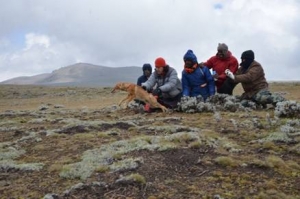Rabies in Ethiopia threatens the survival of the Ethiopian wolf
The Current Situation – September 2014
Fewer than 500 Ethiopian wolves remain, meaning that they are three times more rare than giant pandas. The Ethiopian Wolf Conservation Programme that was started nearly 30 years ago and Professor Claudio Sillero has been working tirelessly with Ethiopian officials and locals to secure a future for this beautiful and endangered national treasure.

A L Harrington
Farmers continue to encroach wolf habitat, bringing with them domestic dogs that risk passing the lethal rabies virus to their wild cousins. Although many of EWCP’s field efforts seek to minimize the risk of rabies in Bale, an outbreak could potentially wipe out the last remaining wolves.
A few weeks ago, our greatest fear was realized when a dead wolf tested positive for rabies. Since then there have been a further 6 confirmed deaths.
Claudio and EWCP, immediately set up an Emergency Response Team and have been busy battling wet and blustery weather at 4,100 meters to capture and vaccinate the wolves of Sanetti Plateau.
They need your help to fund this intervention to:
- Stop this outbreak in its tracks;
- To vaccinate domestic dogs in nearby villages;
- Monitor the wolves’ health throughout the next year.
Here’s how you can help:
You can donate via the following ways:
Lobelia Press has generously offered to donate to the emergency efforts 100% of proceeds from any copies of Lobelia Press’s award-winning The Ethiopian Wolf: Hope at the Edge of Extinction purchased.
We hope that together we can give the Ethiopian wolves a sustainable future.

Team releasing a vaccinated juvenile wolf
Join Prof Claudio Sillero in The Bale Mountains on a special Ethiopian Wolf Expedition this November and see the wolves and his work for yourself. am r
juvenile wol
Please also take a moment to read the latest newsletter from the “wolf man”, Claudio Sillero, where he reports on the latest EWCP work and news.

